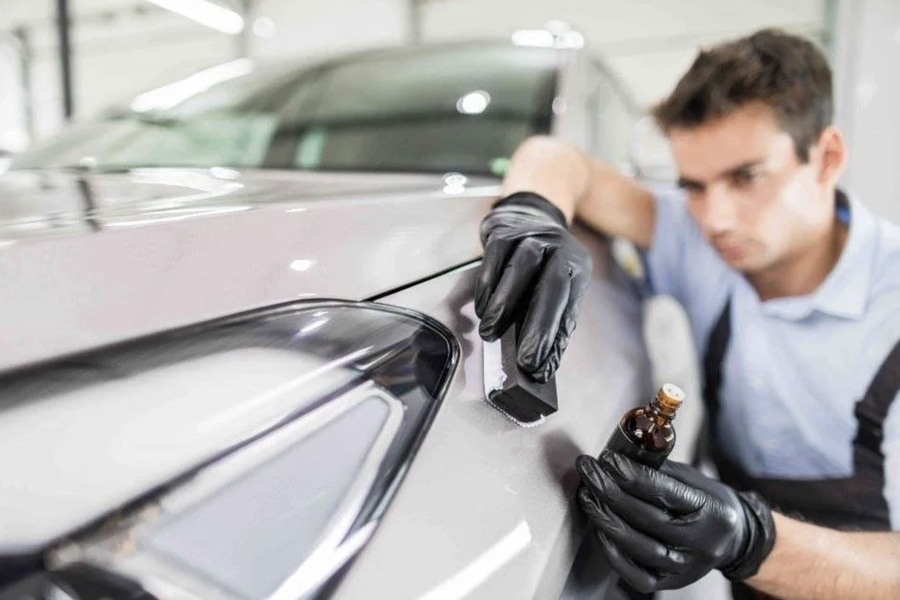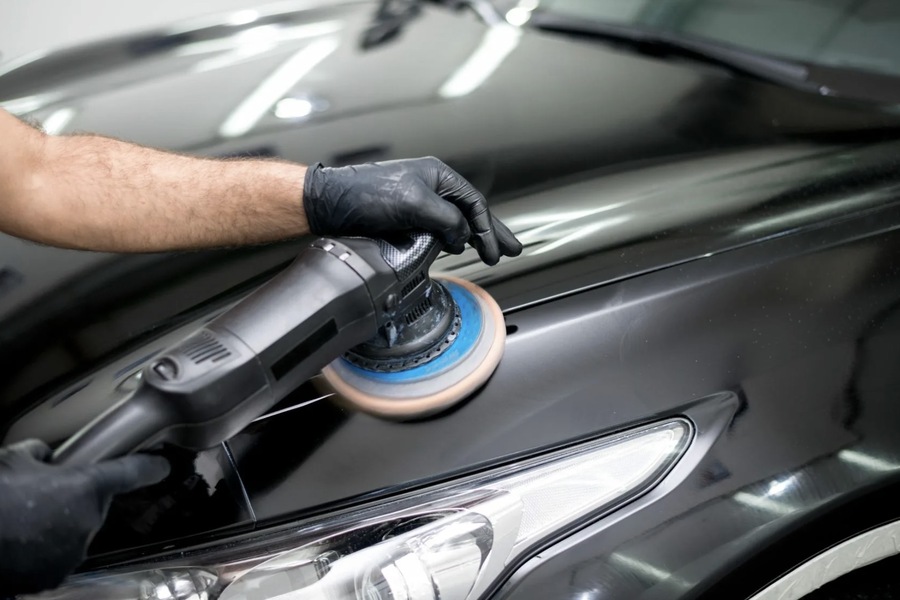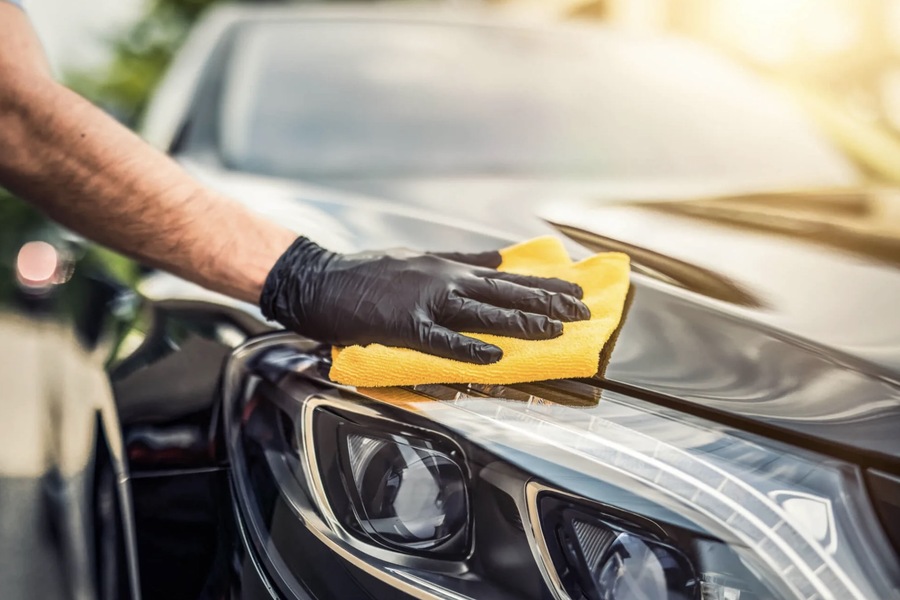Car polishing goes beyond a mere shine; it’s a methodical process designed to restore the brilliance, smoothness, and longevity of a vehicle’s finish. Through the careful removal of fine scratches, “cobweb” patterns, and small abrasions, a professional car polishing service revitalizes various surfaces, from body paint to headlight lenses. This comprehensive guide details the polishing process, its benefits, the techniques involved, and how to extend the results.
What Is Car Polishing and Why Is It Important?
Car polishing is the process of refining the vehicle’s exterior by smoothing out tiny imperfections and scratches that accumulate over time. This procedure isn’t limited to the body paint but extends to areas like headlights, taillights, moldings, wheel rims, and chrome accents. Skilled detailers may even polish interior plastic and decorative elements for a complete refresh.
Purpose of Polishing: The primary purpose of polishing is to remove minor scratches, chips, and imperfections. These often appear as tiny depressions in the paint, which create a dull look and diminish the reflective quality of the paintwork. By leveling the surface and removing a thin layer of the clear coat, polishing restores a flawless finish, enhancing the car’s overall aesthetics and preventing further damage. A well-polished car doesn’t just look good—it’s also better protected from rust, moisture damage, and surface deterioration.
Preparing the Car for Polishing
Preparation is essential to avoid introducing new scratches and to achieve the best polishing outcome. Here’s the typical preparation process:
- Initial Wash
The car is thoroughly washed using a two-phase approach. First, foam and water are used for a contactless wash to remove visible dirt, dust, and debris, preventing these particles from scratching the surface during the polishing process. - Deep Clean with Special Compounds
After the initial wash, detailing specialists apply specific cleaning agents designed to tackle stubborn dirt and contaminants, like industrial grime and tar. This step is done manually with soft sponges to avoid scratching the paint. - Removal of Bitumen and Stubborn Stains
Tough stains such as bitumen or tar can be treated with specialized, paint-safe cleaning agents. These compounds help dissolve sticky residues without damaging the paint. - Clay Bar Treatment
To remove remaining particles and leave the paint silky smooth, a clay bar is used. This step is critical in eliminating microscopic contaminants embedded in the paintwork, which a regular wash cannot remove.

Types of Car Polishing Techniques
The polishing method is selected based on the car’s condition and the owner’s preference for finish. Here are the three main types of car polishing available in professional detailing:
- Standard Polishing
This approach removes a layer of varnish using a coarse abrasive paste, making it ideal for tackling moderate scratches and surface flaws. Conducted in two to three stages, standard polishing starts with a heavy compound to smooth out more noticeable imperfections, followed by a finer polish to restore gloss and clarity. - Light Polishing (Restorative Polishing)
This two-step technique targets micro-scratches and faint “cobweb” marks caused by dust or sand. It relies on fine and micro-grained abrasives instead of coarse ones, making it perfect for relatively new vehicles or cars with minor damage. Light polishing can take between 6 and 12 hours depending on the vehicle’s size and desired outcome, delivering a fresh and smooth look without excessive removal of the clear coat. - Finish Polishing
This final, refined stage uses only micro-grained pastes to achieve a mirror-like shine. Finish polishing prepares the surface for a protective layer, such as a ceramic coating or sealant, and is typically a shorter procedure lasting 3 to 5 hours. The thickness removed is less than 1 micron, preserving the paint while delivering a premium finish.
Recognizing When Your Car Needs Polishing
While some may choose to polish their cars as part of regular maintenance, there are specific indicators that a car will benefit from polishing:
Loss of Shine and Color
Over time, exposure to the elements—especially sun, rain, and dirt—dulls the paint, reducing depth and vibrancy. Polishing can revive the color and restore that showroom-quality shine.
Minor Scratches and Abrasions
Small scratches from branches, dust, or road debris can add up, creating a weathered look. Polishing smooths these blemishes to restore a clean, unblemished finish.
Appearance of “Cobweb” Marks
Fine scratches that resemble cobwebs appear on the paint due to contact with dirt, dust, or improper washing. These marks can be effectively erased through restorative polishing.
Matte Surface Areas
Matte patches signal that the protective layer has worn away. Polishing restores a glossy, smooth surface that enhances the vehicle’s appearance.
Stains from Water and Tree Resin
Hard water spots and sticky residues from trees can etch into the paint if not addressed promptly. Polishing removes these stains, restoring a clean and smooth surface.
The Benefits of Regular Car Polishing
Polishing offers a range of benefits that not only improve your car’s appearance but also extend its longevity:
Enhanced Visual Appeal
Polishing revives the car’s color and shine, bringing out a rich, deep gloss and restoring a like-new appearance.
Easier Maintenance
A polished car repels dust and water, allowing it to stay cleaner longer. The smooth surface helps water and dirt roll off, reducing the frequency of washes.
Protection Against Further Damage
By smoothing out tiny scratches and closing micro-cracks, polishing prevents dirt, water, and other contaminants from getting trapped, which could lead to rust or further damage.
Prevention of Rust
Polishing removes scratches that could allow moisture to penetrate the paint and reach the metal beneath, which would eventually cause rust if untreated. Regular polishing, combined with a protective layer, helps keep the car rust-free.
How Often Should You Polish Your Car?
The frequency of polishing depends on factors like usage, environmental conditions, and personal preference. Typically, it is recommended to polish your car 1-2 times a year, but cars exposed to heavy pollution, frequent rain, or intense sun may require more frequent polishing. Those who drive in harsh climates or on rough roads may also benefit from polishing their car more frequently.
Pro Tips for Extending the Polishing Effect
The polishing effect lasts as long as the car remains scratch-free and the clear coat is intact. Here’s how to extend the life of a polish job:
Use Clean, Soft Microfibers for Drying
Regular cloths or brushes can scratch the paint. Use a dedicated microfiber cloth to dry your car after washing to maintain the smooth surface.
Visit Professional Detailing Centers
Detailing centers use specialized techniques and equipment to handle polished surfaces gently, reducing the risk of introducing new scratches.
Apply Ceramic or Wax Coatings
Protecting your polished car with a ceramic or wax coating shields it from UV rays, dirt, and water spots. The protective layer acts as a barrier, extending the polish effect.
Avoid Brushes in Winter
Snow-removal brushes can easily scratch the paint. Only clear essential areas like the windshield and windows to avoid scraping the body paint.
Wash Carefully
Avoid automatic car washes that may use abrasive brushes. Hand washing with gentle, clean tools is best for maintaining a polished surface.

Additional Protection Options After Polishing
After polishing, many drivers opt to apply a protective layer to safeguard the newly restored paint:
Ceramic Coating
A popular choice, ceramic coatings offer long-lasting protection by forming a chemical bond with the paint. Ceramic coatings repel water, dust, and contaminants, preserving the shine for up to two years.
Waxing
Although not as durable as ceramic coatings, waxing adds a layer of shine and provides several months of protection against water and UV rays.
Paint Sealant
Paint sealants offer a synthetic option for those looking for a high gloss with longer-lasting effects than wax. Sealants can last from six months to a year, making them a practical choice for preserving a polished surface.
How Long Does the Polishing Effect Last?
With good maintenance practices, a professional polish can last up to 1-2 years. Factors such as exposure to harsh weather, frequent washing, and abrasive cleaning tools can shorten the effect’s lifespan. However, when cared for properly, the glossy finish will remain vibrant and resilient. Regular washing with soft microfiber cloths, occasional waxing, and avoiding harsh car washes will prolong the polished effect.
Final Thoughts: The Investment in Car Polishing
Car polishing is more than just cosmetic; it’s a preventive measure that keeps a car in peak condition. For those who take pride in their vehicle’s appearance and want to extend its lifespan, polishing is an invaluable process. Regular polishing, combined with proper washing and protective coatings, will keep your car looking pristine while enhancing its resale value. By removing blemishes, polishing reveals the car’s true color depth and reflective qualities, giving it that “just-off-the-lot” look that car enthusiasts love.

I am happy to give reasonable advice on budgeting to people with any income level. I currently live in Portland, Oregon, and am ready to do freelance assignments and make presentations.
